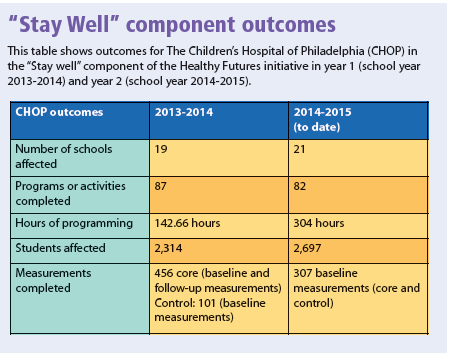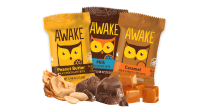School is second only to family as the most influential environment in a child’s life. For some children, school is even more influential than family. School is where children get an education, learn healthy behaviors and social skills, and ideally, receive health care and important medical screenings.
Unfortunately, a school funding crisis in the Philadelphia school district led to layoffs of more than 25% of the district’s certified school nurses. Currently, up to 80% of children in schools without full-time school nurses don’t receive state-mandated school health screenings. Many of these children have no regular source of health care and health education.
The Children’s Hospital of Philadelphia (CHOP), a Magnet®-recognized organization, had the opportunity to become part of an innovative collaborative funded by the Independence Blue Cross (IBC) Foundation. The Foundation’s Healthy Futures initiative is a comprehensive, multipronged 3-year initiative to improve health and reduce obesity in school-age children. The initiative partners with best-in-class organizations to encourage children in 25 elementary schools in three components—“Eat right,” “Get fit,” and “Stay well.” Partners in the program include:
- two well-known restaurant foundation groups and a farm-to-table—based organization spearheading the “Eat right” component
- professional soccer, tennis, and basketball teams, along with a fitness expert, challenging the children to “Get fit”
- CHOP, which provides health promotion programming and state-mandated screenings
to lead the “Stay well” component.
Screening data are included in a 3-year prospective study through a local university partnership tracking fourth-grade students as they progress through fifth and sixth grades. Data are collected for each child, including height, weight, body mass index, and waist circumference, as well as other quantitative and qualitative measures. Schools are categorized as core, level 1, level 2, and control schools, which vary based on the intervention dosage each school receives.
Schools in the program were selected from Philadelphia and four surrounding counties, representing a wide socioeconomic spectrum. Core schools receive services from all partners in the project, while control schools receive only the growth-measure component of state-mandated screenings. Level 1 and level 2 schools receive fewer interventions in all components of the Healthy Futures program.
With support from the IBC Foundation, CHOP hired and trained a certified school nurse to serve in the Healthy Futures program. A CHOP nurse meets with the certified school nurse to assess health needs, set up meetings with each school to schedule screenings, and provide targeted health promotion to meet identified needs. Working with the certified school nurse, the CHOP nurse assists with sick and injured children and supports the school’s health needs. (See “Stay Well” component outcomes.)
Program outcomes
In the first year of the program, 100% of state-mandated screenings were completed for three of the four core schools. Ninety-five percent of state-mandated screenings, including more than 500 baseline measurements, were completed for the Philadelphia public school in the core cohort, which previously reported only a 73% completion rate. Also, several students from each of the four core schools were referred for additional vision testing, and scoliosis screening resulted in referrals for several students at one school. A CHOP school nurse gathered annual immunization compliance data in one school and partnered with the school administration to improve compliance rates.
The “Stay Well” curriculum includes wellness programs based on the schools’ self-identified wellness needs. Programs are developed and individualized to meet the school’s environment and identified needs. Wellness programming includes sessions on such topics as healthy eating, proper exercise, and the importance of regular physician and dental visits. Other wellness programs address such topics as puberty, personal hygiene, and trauma prevention and include pedestrian and playground safety, bike/helmet and all-terrain vehicle safety, and water and sun safety.
Through the Healthy Futures initiative, CHOP is able to bring its expertise and leadership in nursing to participating schools. Expert trauma nurses and critical care nurses provide trauma prevention education. Respiratory care experts provide asthma education to school staff to help improve disease awareness. Staff learn how to read and interpret asthma action plans, recognize distress signs, and properly administer inhalers with a spacer.
Structural empowerment and CHOP’s intervention
The 2014 Magnet® Application Manual states that “Magnet-recognized organizations promote and develop strong partnerships with community organizations to improve patient outcomes and advance the health of the communities they serve.” As a three-time Magnet-recognized organization, CHOP responded to a lack of professional nursing presence in area schools. Through its partnership with the IBC Foundation, it hired a school nurse to augment school nurse services and offer innovative programming based on school-identified health promotion needs.
Next steps
The first and second years of the “Stay Well” component of the Healthy Futures initiative have yielded much information about participating students, their families, and the school communities. In most schools, asthma prevalence is high. We plan to include the CHOP Community Asthma Prevention Program’s education lessons in future health promotion activities.
In year 3 of the program (school year 2015-2016), students will be sixth graders and will have 2 years of Healthy Futures programs. They will be invited to become “health ambassadors,” teaching health promotion topics to other students, family, and friends. Also in year 3, we will add a pediatric nurse practitioner (PNP) to the program to perform mandated physical exams for children lacking this screening. The PNP will provide advanced assessment skills and referrals.
Empowering children for a healthy future
The Healthy Futures program has enabled CHOP to affect schools and the health and wellness of communities throughout the region in an unprecedented way, using an integrated approach of nutrition, activity, and wellness. The CHOP school nurse demonstrates the value of the nurse to child health. Schools can focus on their primary objective of education because children’s health is improved through all program components. Healthy children are present and active in their education.
When the program comes to a close, children will be empowered to participate actively in their own healthy futures and to support their families to have healthier eating and exercise habits. Individualized health promotion modules and educational supports will remain with the schools and can be implemented by school staff.
Selected references
American Nurses Credentialing Center. 2014 Magnet® Application Manual. Silver Spring, MD: American Nurses Credentialing Center; 2014.
National Association of School Nurses. School Nurse Workload: Staffing for Safe Care. In: National Association of School Nurses. Position Statements. Resolutions and Consensus Statements. Revised January 2015. https://www.nasn.org/portals/0/binder_papers_reports.pdf


















